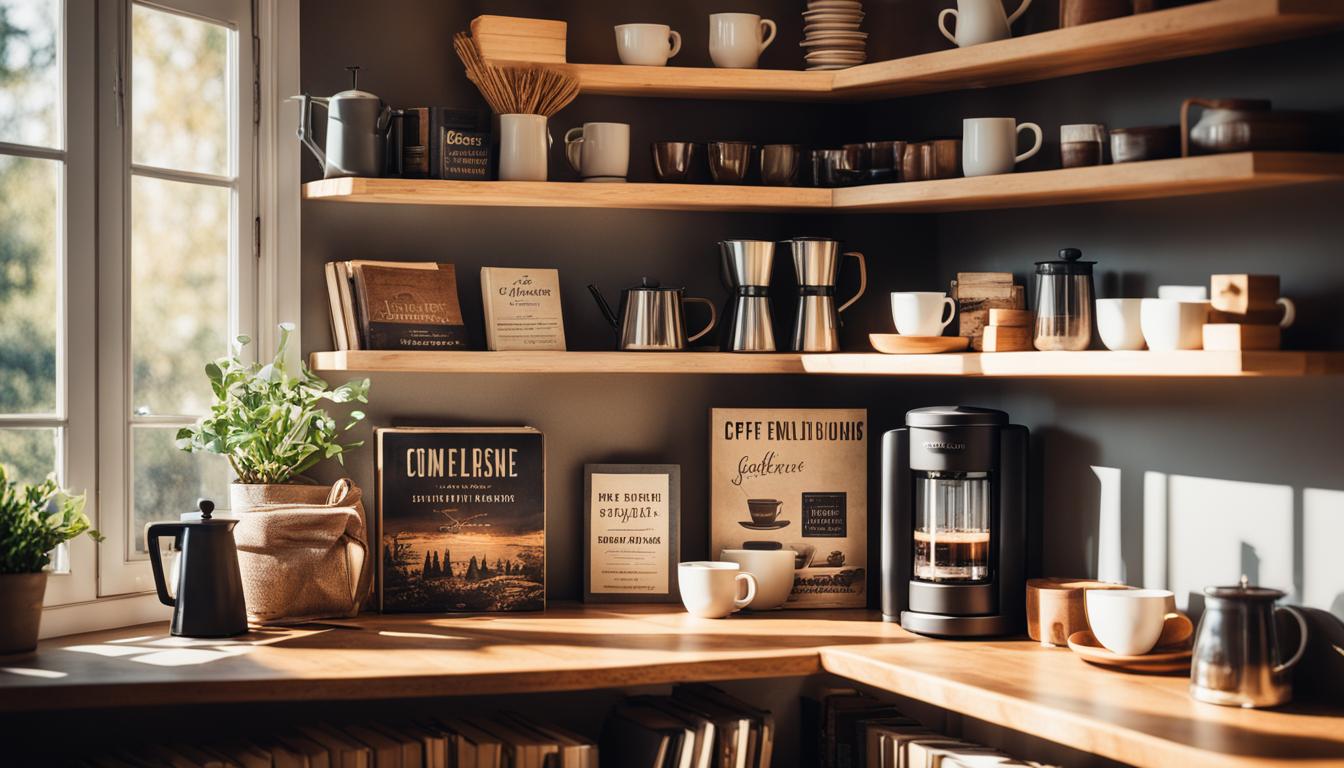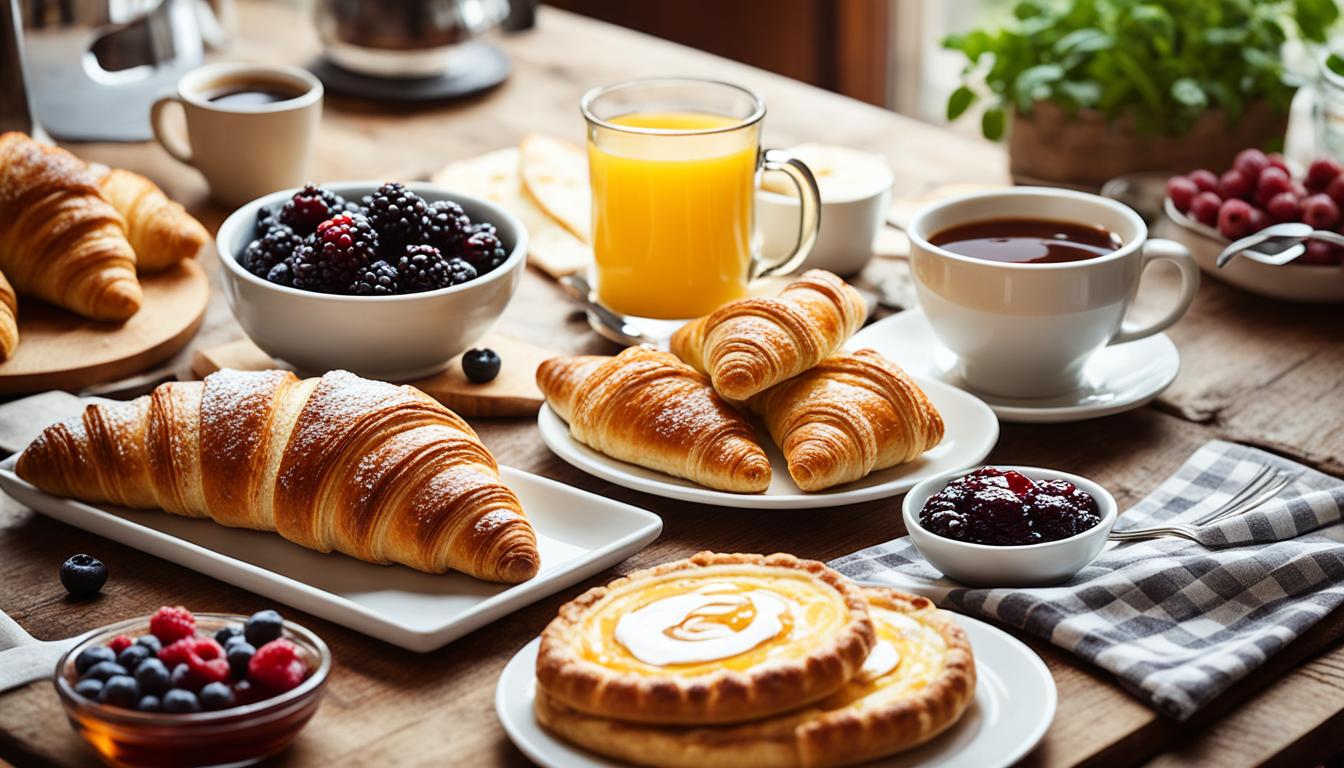Welcome to our comprehensive guide on creating a memorable coffee tasting experience at home. If you’re a coffee lover looking to explore new flavors and enhance your palate, this guide is for you. We’ll take you through the process of selecting the perfect beans, brewing techniques, and flavor profiles, so you can become a true coffee connoisseur. Get ready to brew and savor the finest coffee in the comfort of your own home!
Key Takeaways:
- Discover the essentials of coffee tasting, from aroma to acidity and body to finish.
- Learn how to choose high-quality coffee beans to enhance your tasting experience.
- Explore different brewing methods and their impact on flavor and aroma.
- Create a dedicated tasting station and set the perfect ambiance for your coffee tasting.
- Master tasting techniques and effective note-taking for a successful coffee tasting.
The Basics of Coffee Tasting
Before diving into the world of coffee tasting, it’s important to understand the basics. We’ll explore the key elements to consider when tasting coffee, from aroma and acidity to body and finish. Learn how to evaluate each aspect and appreciate the nuances of different coffee flavors.
Understanding Aroma
One of the first things to pay attention to when tasting coffee is its aroma. Take a moment to inhale the fragrance deeply, allowing the aroma to envelop your senses. Aroma can give you clues about the coffee’s origin, roast level, and flavor profile. Note any specific scents you detect, such as floral, fruity, or nutty notes.
Assessing Acidity
Acidity refers to the brightness or liveliness of the coffee. It is not the same as sourness. High acidity can bring out the complexity and distinctness of flavors. When tasting, notice if the coffee has a crisp or sharp acidity, or if it leans more towards a mellow and smooth profile. Consider how the acidity interacts with other flavor components.
Evaluating Body
The body of coffee refers to its mouthfeel, or the sensation it creates on your palate. It can range from light and delicate to heavy and full-bodied. Pay attention to the weight and texture of the coffee as you sip. Does it feel silky, creamy, or thin? A coffee with a fuller body often has a more pronounced taste and lingering finish.
Exploring the Finish
The finish, also known as the aftertaste, is the lingering flavor that remains after you have swallowed the coffee. Assess how long the flavors linger and whether they are pleasant or lingering. Some coffees may have a clean, crisp finish, while others may leave a lingering sweetness or bitterness on the palate.
By understanding these key elements of coffee tasting, you’ll be better equipped to evaluate and appreciate the quality and complexity of different coffees. Take your time when tasting and immerse yourself in the sensory experience. Let the flavors and aromas transport you to the origins of the coffee beans.
Next, we’ll dive deeper into selecting the right beans for your coffee tasting session. Whether you prefer single-origin beans or blends, there’s a wide range of options to explore. Join us in the next section as we uncover the world of coffee beans and their unique flavor profiles.
Selecting the Right Beans
The foundation of a great coffee tasting starts with selecting the right beans. At Brew & Savor, we understand that the quality of the coffee beans greatly impacts the overall tasting experience. That’s why we’re dedicated to guiding you through the process of choosing the best coffee beans for your coffee tasting.
When selecting beans for your tasting, consider the following factors:
- The Origins: Coffee beans come from various regions around the world, each boasting unique flavor profiles. From the high-altitude mountains of Ethiopia to the lush plantations of Colombia, different coffee origins offer distinct characteristics that can elevate your tasting experience.
- The Roasts: The degree of roasting greatly affects the taste of coffee. Light roasts are known for their delicate flavors and bright acidity, while dark roasts feature bold, rich flavors and a fuller body. Experimenting with different roast levels allows you to discover your personal preferences.
- The Flavor Profiles: Coffee beans exhibit a range of flavor profiles, including fruity, floral, nutty, chocolatey, and more. Exploring the diverse flavor range can open up a world of possibilities and help you develop a deeper appreciation for the complexity of coffee.
So how can you find the best coffee beans for your tasting experience? We recommend exploring specialty coffee shops, local roasters, or reputable online retailers that curate high-quality beans. Look for beans that are freshly roasted, as this ensures optimal flavor and aroma.
“The right beans are the key to unlocking a truly exceptional coffee tasting experience. From exotic origins to expertly roasted varieties, the world of coffee invites us on a flavorful journey.” – Brew & Savor
Once you have selected your beans, it’s time to move on to the next step: brewing methods. In the next section, we’ll explore different brewing techniques that will enhance the flavors captured in your carefully selected beans.

Brewing Methods for Tasting
When it comes to coffee tasting, the brewing method you choose can greatly impact the flavor and aroma of your cup. In this section, we will explore various techniques such as pour-over, French press, and espresso, and highlight how each method contributes to the overall tasting experience.
Pour-Over
One popular brewing method for coffee tasting is the pour-over method. This technique involves pouring hot water over fresh coffee grounds, allowing for a controlled extraction that brings out the unique flavors of the beans. The slow and precise pour results in a clean and well-balanced cup of coffee, perfect for discerning aroma and taste notes.
French Press
For those seeking a bolder and more robust coffee tasting experience, the French press method is an excellent choice. This brewing technique involves steeping coffee grounds in hot water and then using a plunger to separate the liquid from the grounds. The result is a rich and full-bodied coffee with a pronounced flavor profile and indulgent mouthfeel.
Espresso
Espresso, known for its intense flavor and strong aroma, is another brewing method to consider for your coffee tasting. This method involves forcing hot water through finely ground coffee under high pressure, resulting in a concentrated shot of bold and flavorful espresso. Espresso is the foundation of many coffee-based beverages and can be enjoyed on its own for a concentrated tasting experience.
Now that we’ve explored these key brewing methods, let’s take a closer look at how they compare in terms of flavor, strength, and brewing time:
| Brewing Method | Flavor | Strength | Brewing Time |
|---|---|---|---|
| Pour-Over | Mild to medium, well-balanced | Medium | 2-4 minutes |
| French Press | Full-bodied, bold | Strong | 4-5 minutes |
| Espresso | Intense, concentrated | Extra strong | 20-30 seconds |
The brewing method you choose for your coffee tasting will depend on your personal preferences and the desired tasting experience. Whether you prefer the nuanced flavors of pour-over, the boldness of French press, or the intensity of espresso, each method offers a unique journey into the world of coffee flavors.
Setting Up Your Tasting Station
Create an inviting and comfortable space for your coffee tasting. Hosting a coffee tasting is a wonderful way to bring friends and fellow coffee enthusiasts together for a delightful experience. To make your coffee tasting party a success, here are some tips on setting up your dedicated tasting station:
Gather the Necessary Equipment and Tools
Before hosting a coffee tasting, ensure you have the essential equipment and tools on hand. Here’s a list of items you’ll need:
- Coffee brewing equipment (pour-over, French press, espresso machine, etc.)
- A grinder to grind fresh coffee beans
- Coffee mugs or tasting cups
- Filtered water for brewing
- Spoons for stirring
- Napkins or cupping spoons for tasting

Presenting Your Coffee Samples
When presenting your coffee samples, it’s important to arrange them in a clear and organized manner. Consider using a tray or a designated area to display the different coffee varieties. Label each sample with the name, origin, and roast level for easy identification.
Provide Tasting Notes
Offer guests tasting notes that describe each coffee’s unique characteristics and flavor profile. These notes can include details about the coffee’s aroma, body, acidity, and tasting notes such as chocolate, fruitiness, or nutty undertones. Encourage guests to compare and discuss their impressions.
Create a Memorable Atmosphere
Ambiance plays a crucial role in elevating the coffee tasting experience. Consider setting up some cozy seating areas, playing soft background music, and adorning the space with coffee-related decor. Dim lighting and scented candles can also help create an intimate and relaxed atmosphere.
“A well-organized tasting station with a thoughtful presentation enhances the overall coffee tasting experience, allowing guests to fully appreciate the nuances of each coffee.”
By following these tips, you’ll create a welcoming and enjoyable coffee tasting party. Now that your tasting station is set up, it’s time to move on to the next section, where we’ll discuss tasting techniques and note-taking to deepen your coffee knowledge and appreciation.
Tasting Techniques and Note-Taking
Developing your palate and tasting skills is essential for a successful coffee tasting. To fully appreciate the complex flavors and aromas of different coffees, it’s important to know how to evaluate them effectively.
Assessing Aroma, Flavor, and Body
When tasting coffee, pay close attention to its aroma, flavor, and body. The aroma allows you to experience the first impression of the coffee, while the flavor helps you identify the various taste notes present. The body refers to the coffee’s texture and mouthfeel.
“The aroma of freshly brewed coffee is an indulgent experience that sets the stage for the tasting journey.” – Coffee Expert
Start by taking a moment to inhale the coffee’s aroma. Close your eyes and let the fragrance envelop your senses. Note any distinctive scents, such as floral, fruity, or nutty undertones.
Next, take a small sip of the coffee and let it coat your entire palate. Pay attention to the flavors that emerge. Are they sweet, acidic, or bitter? Can you detect hints of chocolate, citrus, or caramel?
As you savor the coffee, consider its body. Is it light, medium, or full-bodied? Does it feel smooth, velvety, or oily on your tongue?
Taking Tasting Notes
Taking notes during your coffee tasting allows you to capture your thoughts and observations. When jotting down your impressions, use descriptive language and be specific about the aromas, flavors, and body you perceive.
“Note-taking helps us remember the distinct characteristics of each coffee and compare our experiences.” – Coffee Tasting Enthusiast
Consider using a coffee tasting wheel, a visual tool that categorizes different flavor profiles, to help identify specific tastes. You can find downloadable coffee tasting wheels online.
Record key details such as the origin and roast level of the coffee, brewing method, and any brewing parameters that may influence the taste. This allows you to recreate your favorite coffees and share your tasting experiences with others.
Sample Coffee Tasting Notes
| Sample Coffee | Aroma | Flavor | Body |
|---|---|---|---|
| Ethiopian Yirgacheffe | Fragrant with notes of jasmine and bergamot | Bright acidity with hints of tropical fruit and floral undertones | Light-bodied with a silky mouthfeel |
| Colombian Supremo | Aromas of caramel and roasted nuts | Rich chocolatey flavors with a subtle citrus acidity | Medium-bodied with a smooth and velvety texture |
Keep in mind that taste preferences are subjective, so don’t be afraid to experiment and trust your own palate. Happy coffee tasting!
Pairing Coffee with Food
Enhance your coffee tasting experience by pairing different coffee flavors with complementary food items. The art of flavor pairing can elevate the taste and aroma of your coffee, creating a harmonious and enjoyable sensory experience. Here are some suggestions for food pairings that will enhance your coffee tasting experience:
Dark Chocolate and Espresso
The rich and intense flavors of dark chocolate complement the robust and bold flavors of espresso. The bitterness of the chocolate contrasts with the smoothness of the coffee, creating a perfect balance of flavors. Savor a piece of high-quality dark chocolate while sipping on a freshly brewed espresso for a decadent and satisfying pairing.
Buttery Croissant and Medium Roast Coffee
Indulge in the buttery goodness of a freshly baked croissant while enjoying a cup of medium roast coffee. The flaky texture of the croissant pairs well with the balanced flavors of a medium roast coffee, enhancing the nutty and caramel notes. The combination of these two delights will awaken your taste buds and leave you wanting more.
Berries and Light Roast Coffee
The bright and fruity flavors of berries complement the delicate and floral notes of a light roast coffee. Whether it’s strawberries, blueberries, or raspberries, the natural sweetness and acidity of the berries enhance the nuanced flavors of the coffee. Take a bite of fresh berries alongside a cup of light roast coffee for a refreshing and vibrant pairing.
Spiced Nuts and Dark Roast Coffee
The earthy and smoky flavors of a dark roast coffee pair wonderfully with the warmth and crunch of spiced nuts. Whether it’s cinnamon, cloves, or nutmeg, the aromatic spices in the nuts harmonize with the bold flavors of the coffee, creating a comforting and satisfying combination. Enjoy a handful of spiced nuts with a cup of dark roast coffee for a delightful sensory experience.
Cheese and Cold Brew Coffee
Explore the world of cheese pairings with the smooth and velvety taste of cold brew coffee. The creamy and savory flavors of cheese, such as Gouda or Brie, complement the mellow and subtle flavors of cold brew coffee. Experiment with different cheese varieties and discover your favorite pairing for a sophisticated and elegant coffee tasting experience.
| Food | Coffee Flavor | Pairing Notes |
|---|---|---|
| Dark Chocolate | Espresso | The bitterness of dark chocolate contrasts with the boldness of espresso, creating a harmonious balance of flavors. |
| Buttery Croissant | Medium Roast Coffee | The flaky texture of a croissant complements the balanced flavors of a medium roast coffee, enhancing nutty and caramel notes. |
| Berries | Light Roast Coffee | The bright and fruity flavors of berries enhance the delicate and floral notes of a light roast coffee, creating a vibrant combination. |
| Spiced Nuts | Dark Roast Coffee | The earthy and smoky flavors of spiced nuts harmonize with the boldness of a dark roast coffee, creating a comforting pairing. |
| Cheese | Cold Brew Coffee | The creamy and savory flavors of cheese complement the smooth and subtle taste of cold brew coffee, offering an elegant pairing. |
Experiment with these pairings and let your taste buds guide you to discover unique and delicious combinations. Remember, the key is to find flavors that complement and enhance each other, creating a memorable coffee tasting experience. Happy pairing!
Conclusion
Creating a coffee tasting at home can be a delightful and educational experience. With the right knowledge and techniques, you can engage your senses and explore the vast world of coffee flavors. Whether you’re hosting a coffee tasting party or simply enjoying a solo coffee exploration, this guide has equipped you with the tools to brew and savor the perfect cup of coffee.
FAQ
What is a coffee tasting?
A coffee tasting, also known as a cupping, is a method of evaluating the aroma, flavor, and body of different coffee beans. It involves carefully observing and analyzing the sensory characteristics of the coffee to appreciate its unique qualities.
How do I create a coffee tasting at home?
To create a coffee tasting at home, you’ll need high-quality coffee beans, various brewing methods, and a dedicated tasting station. Follow our guide to learn the step-by-step process of selecting the right beans, brewing techniques, and setting up your tasting station.
What are some tips for hosting a coffee tasting party?
Hosting a coffee tasting party can be a fun and educational experience. Ensure you have a variety of coffee beans, different brewing methods, and tasting notes available for your guests. Consider pairing your coffee samples with complementary food items and creating a cozy ambiance for a memorable event.
How do I evaluate the flavor of coffee during a tasting?
When evaluating the flavor of coffee during a tasting, take note of its acidity, sweetness, bitterness, and overall balance. Pay attention to the different flavor notes, such as fruitiness, chocolatey, or nutty undertones. Take small sips and allow the coffee to coat your entire palate to fully appreciate its complexity.
Can I pair coffee with food during a tasting?
Absolutely! Pairing coffee with food can enhance the tasting experience. Look for complementary flavors that can bring out the best in both the coffee and the food. For example, a bright and fruity coffee can pair well with a citrusy dessert, while a dark and rich coffee may complement chocolate-based treats.
What brewing methods are best for a coffee tasting?
The best brewing methods for a coffee tasting vary depending on personal preference and the specific characteristics of the coffee beans. Some popular options include pour-over, French press, and espresso. Each method offers a unique flavor profile, so feel free to experiment and find the one that suits your taste.




